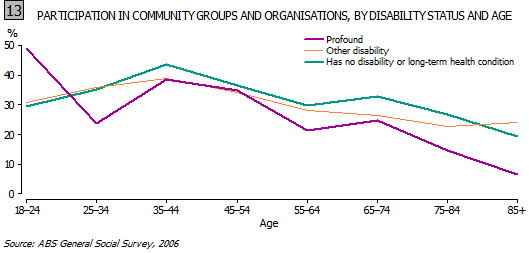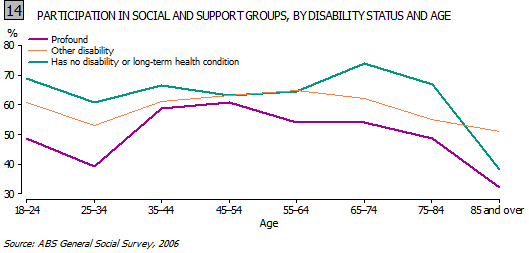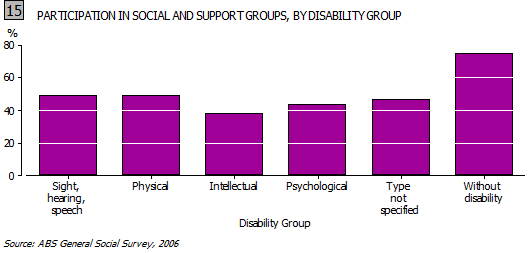 ACTIVE INVOLVEMENT IN GROUPS
ACTIVE INVOLVEMENT IN GROUPS
Membership or participation in groups and organisations is a significant aspect of social participation, civic participation and community support. It has been argued that participation in groups helps develop skills for participation in democracy.4 This suggests if people with disability are learning these skills, it is positively impacting on their capacity to take an active role in political life.
The 2006 General Social Survey showed people with a disability were more likely to have participated in community groups and organisations in the 12 months prior to interview than people without disability (see Graph 13). People with profound or severe disability were most likely to report having attended a health promotion, support group or welfare organisation. In contrast, people without disability reported higher attendance at education and training groups or parenting/child/youth groups.

People with profound or severe disability, living in New South Wales and Queensland, were less likely to have participated in a community support group or organisation in the previous 12 months than other States and Territories. People with no disability, in South Australia and Victoria, reported the least participation in a community group or organisation in the previous 12 months.
People living in outer remote areas of Australia who reported having a disability were more likely to have participated in a community group or organisation in the previous 12 months than their counterparts living in other areas. People without disability, living in outer regional and remote or very remote Australia were more likely to have participated in community groups or organisations than their counterparts in major city or inner regional areas.
Men with profound or severe disability reported participation in health promotion or support groups more than any other type of group, while women with the same disability status reported a higher rate of participation in welfare organisations. For those without disability, the most common types of organisations reported were education and training groups (20% of women and 11% men).
Participation in social and support groups took on a different pattern to participation in community groups and organisations. Participation rates were similar for people with profound or severe disability, compared to those without disabilities in the 35 to 54 years age bracket, while participation rates in these groups were higher for those without disabilities in the younger and older age groups (see Graph 14).

In terms of disability group, people with intellectual disability who also had profound or severe disability were less likely to have participated in social clubs and organisations in the previous 12 months than their counterparts who reported other disability types. However, all people with disability were less likely to have participated in social and support groups than people without disability (see Graph 15).

 Print Page
Print Page
 Print All
Print All